Cannabis Overwatering vs Underwatering: How to Find the Right Balance



Cannabis Overwatering vs Underwatering: How to Find the Right Balance
Water is essential for the health and growth of marijuana plants, but too much or too little can cause serious problems. In this blog post, we will explore the signs and consequences of overwatering and underwatering, and how to find the proper watering frequency and amount for your plants.
• Overwatering Cannabis Plants
Overwatering is a common mistake among novice growers, who may think that cannabis needs constant watering to thrive. However, overwatering can harm your plants by depriving them of oxygen and creating anaerobic conditions in the root zone. This can lead to rootrot, nutrient deficiencies, fungal infections, and stunted growth.
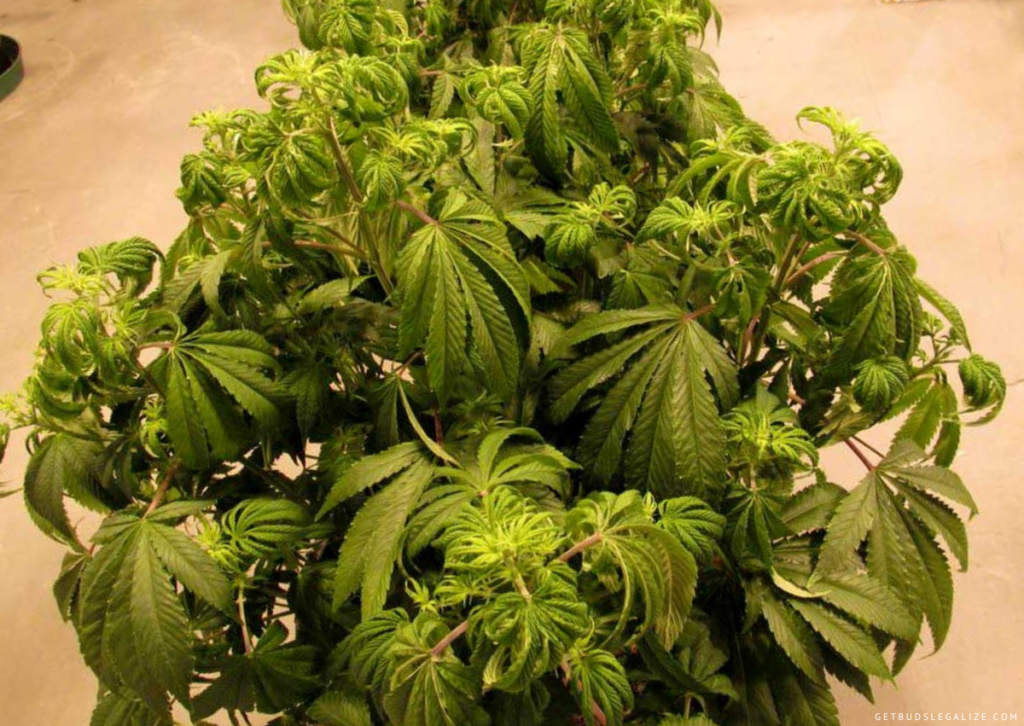
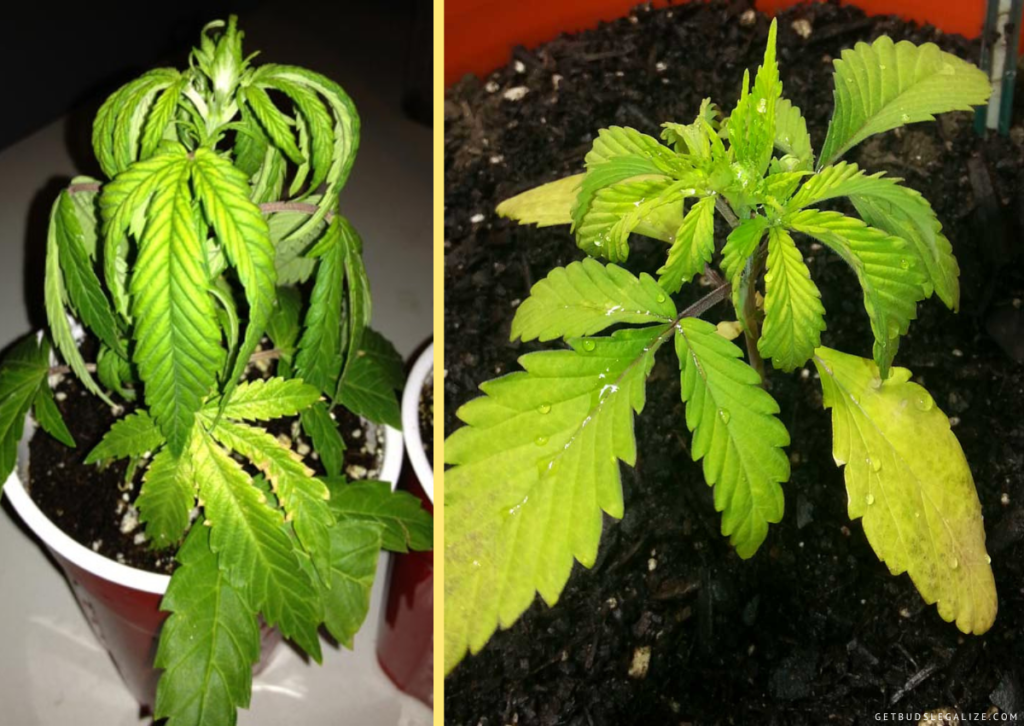
Some of the symptoms of overwatered cannabis are:
- Drooping leaves that are firm and curled inwards. This is because the excess water is pushing into the leaves, making them swell and lose their shape.
- Yellowing leaves that may fall off easily. This is a sign of nutrient deficiency, as overwatered plants cannot absorb nutrients properly from the soil.
- Slow or halted growth. This is due to the lack of oxygen and energy available to the plants, as they are struggling to survive in a waterlogged environment.
- Wilting despite wet soil. This is a sign of root rot, which is a fatal condition that damages the roots and prevents them from absorbing water and nutrients.
How to Fix Overwatering on Plants:
If you notice any signs of overwatering, you should act quickly to prevent further damage. Here are some steps you can take to fix overwatering:
1. Stop watering: The first thing you should do is stop watering your plants until the soil is dry. You can check the moisture level by inserting your finger into the soil up to the second knuckle. If it feels wet or sticky, wait until it feels dry or crumbly before watering again.
2. Improve drainage: The next thing you should do is improve the drainage of your soil and pots. You can do this by adding perlite, vermiculite, coco, or other aerating materials to your soil mix. You can also make sure that your pots have enough holes at the bottom and use a tray or saucer to catch the runoff water.
3. Prune damaged parts: The last thing you should do is prune any damaged parts of your plants, such as rotten roots, yellow leaves, or moldy buds. This will help your plants focus their energy on recovery and prevent further infection.
4. lower the humidity level in your grow room: You can do this by using a dehumidifier, an exhaust fan, an air conditioner, or a heater. You can also increase the air circulation by using oscillating fans or opening windows or vents. Aim for a relative humidity level of 40-60% for vegetative and 30-50% for flowering.
5. Check the size of your pots and make sure they are not too big for your plants: Repot your plants in smaller pots with fresh soil if necessary.


• Underwatering Cannabis Plants
Underwatering is less common than overwatering, but it can also cause serious damage to your plants. The affected plants are deprived of humidity, which is necessary for photosynthesis, transpiration, and the transport of nutrients. Underwatered plants will become dehydrated, stressed, and weak.
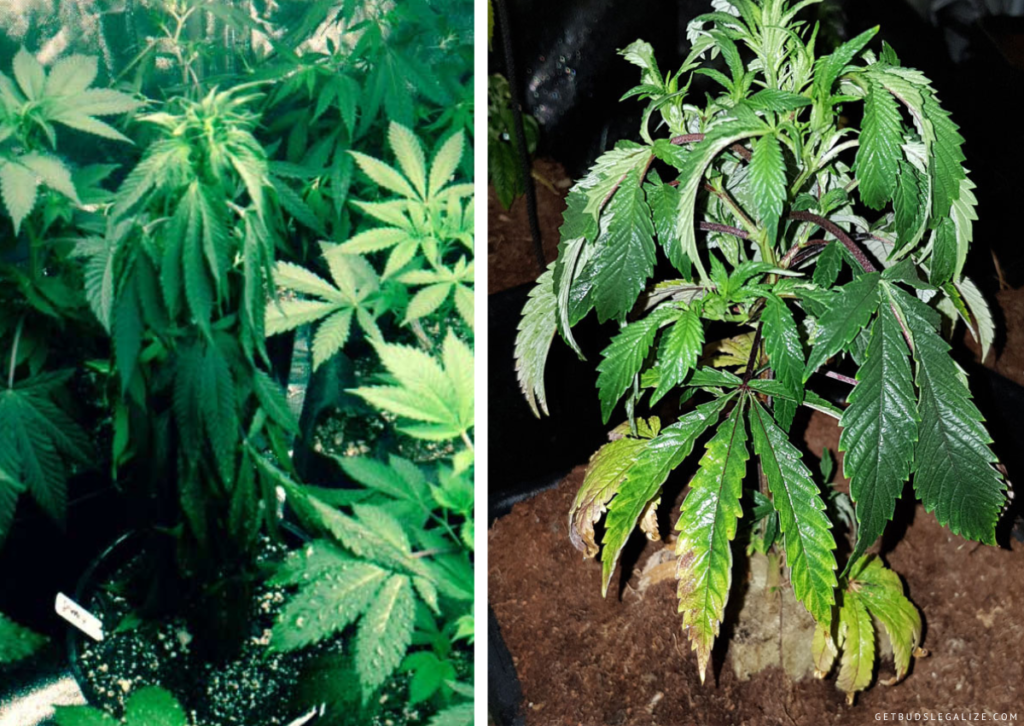
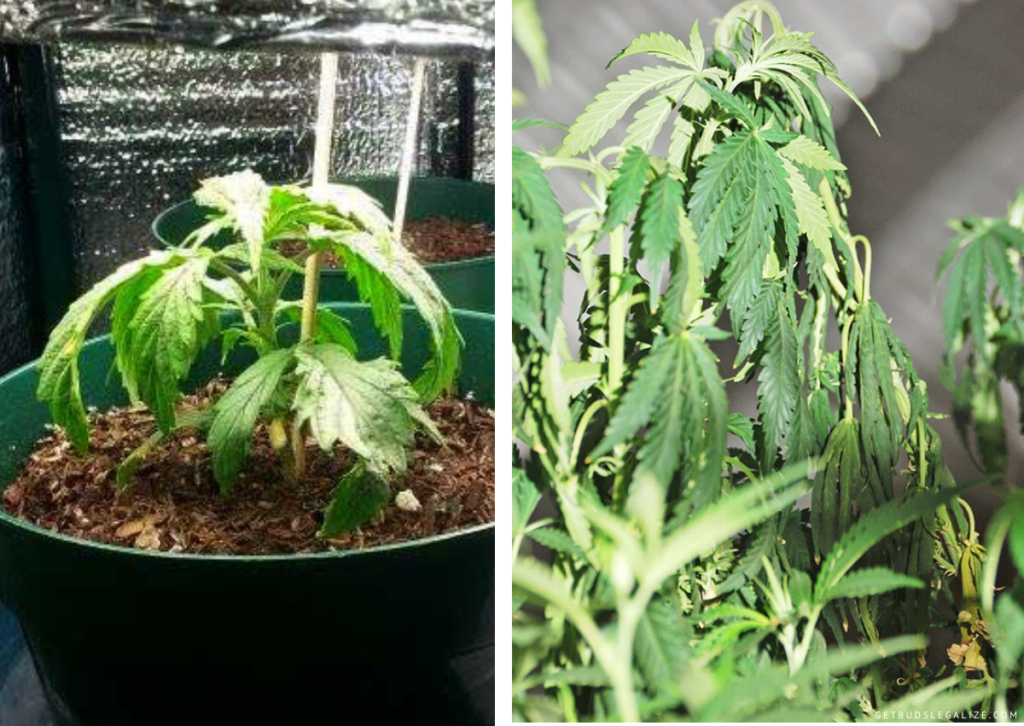
Some of the symptoms of underwatered cannabis plants are:
- Drooping leaves that are dry and brittle. This is because the lack of water causes the leaves to lose their turgor pressure and wilt.
- Brown tips or edges on the leaves. This is a sign of nutrient burn, as underwatered plants cannot dilute the salts in the soil with enough water.
- Leaf drop or curling. This is a way for the plants to conserve water by reducing their surface area and transpiration rate.
- Slow or halted growth. This is due to the lack of water and energy available to the plants, as they are struggling to survive in drought-like conditions.
How to Fix Underwatering on Plants:
If you notice any signs of underwatering, you should act quickly to restore the hydration of your plants. Here are some steps you can take to fix underwatering:
1. Water thoroughly: The first thing you should do is water your plants thoroughly until you see runoff water coming out of the bottom of the pots. This will ensure that the soil and roots are fully hydrated and that any excess salts are flushed out.
2. Adjust the temperature and light intensity in your grow room: You can do this by using a thermometer, a hygrometer, a dimmer switch, or a timer. You can also move your lights higher or lower depending on the stage of growth and the type of light you are using. Aim for a temperature range of 68-77°F (20-25°C) for vegetative and 65-75°F (18-24°C) for flowering. Aim for a light intensity of 400-600 PPFD (photosynthetic photon flux density) for the vegetative and 600-900 PPFD for the flowering.
3. Loosen up your soil mix and make it more water-retentive: You can do this by adding peat moss, compost, worm castings, or other organic materials to your soil mix. You can also use fabric pots, smart pots, or air pots that prevent root binding and allow more water absorption. Make sure to have holes at the bottom of your pots and use saucers or trays to catch the excess water.
4. Water regularly: The next thing you should do is water your plants regularly according to their needs and the environmental conditions. You can use a moisture meter, a weight scale, or a lift test to determine when your plants need water. A general rule of thumb is to water when the top inch of soil feels dry.
5. Check the size of your pots and make sure they are not too small for your plants: Repot your plants in bigger pots with fresh soil if necessary.


How to Find the Right Balance Between Overwatering & Underwatering?
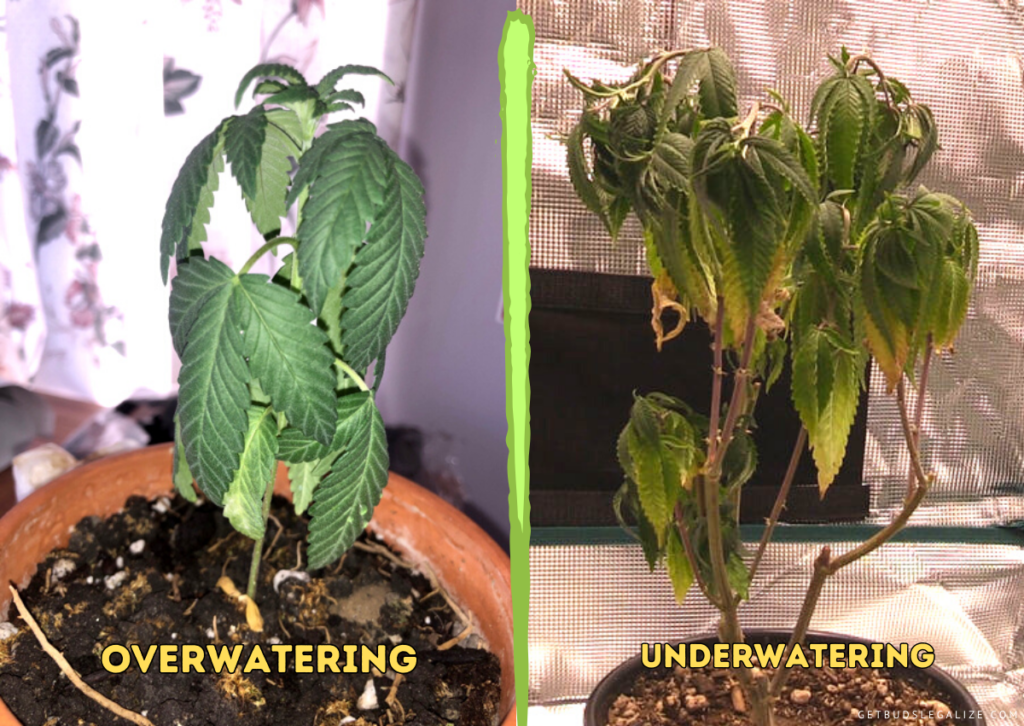 Cannabis Overwatering vs Underwatering
Cannabis Overwatering vs UnderwateringFinding the right balance can be tricky, as it depends on many factors such as the type of soil, pot size, plant size, stage of growth, temperature, humidity, and light intensity. However, some general guidelines can help you achieve optimal watering practices for your plants.
1. Check Your Plants Daily
You should check your plants every day for any signs of overwatering or underwatering. Some signs are more obvious than others, such as wilting, yellowing, or browning of the leaves.
However, some signs are more subtle, such as drooping at night, curling at the edges, or spotting on the leaves. You should also check your plants for any signs of mold or pests, which can indicate overwatering or underwatering as well.
2. Water Your Plants When They Need It, Not On A Fixed Schedule
The best way to tell if your plants need water is by checking the soil moisture and the weight of your pots. If the soil feels dry an inch below the surface, or if your pots feel light when you lift them, it's time to water.
3. Water Your Plants Thoroughly but Infrequently
You want to saturate your soil with water until you see some runoff coming out of the drainage holes, but then let it drain well before watering again. This will ensure that your plants get enough water and oxygen without drowning or drying out.
4. Adjust Your Watering According to Your Plant's Stage of Growth
Cannabis need more water during their vegetative phase than during their flowering, as they have more foliage and faster growth. You may need to water your plants every day or every other day during vegging, but only once or twice a week during flowering.
5. Use Quality Water with a Balanced pH and Low EC (Electrical Conductivity)
The quality of your water affects how well your plants can absorb nutrients from the soil. You want to use water that has a pH level between 6.0 and 7.0 for soil growth, or between 5.5 and 6.5 for hydroponic growth. You also want to use water that has a low EC, which measures the amount of dissolved salts in the water.
High EC water can cause nutrient lockout or burn in your plants. You can use tap water, filtered water, rainwater, or distilled water for your plants, but make sure to test and adjust the pH and EC before watering.


How Does Pot Size Affect Watering Frequency?
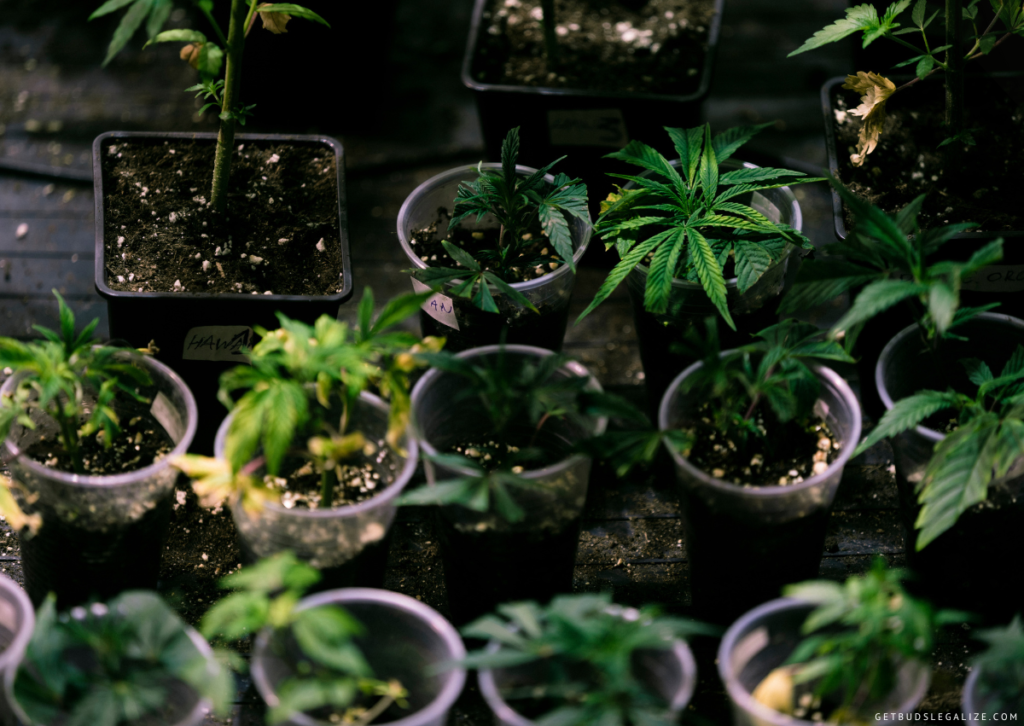
The size of the pot also affects how often you need to water your plants. A smaller pot will dry out faster than a larger pot, so you will need to water more frequently. However, a larger pot will hold more water than a smaller pot, so you will need to water less frequently. The key is to find a pot size that matches the size of your plant and allows for optimal root development.
What Are Some Guidelines for Choosing the Right Pot Size for Your Plants?
The table below shows some approximate guidelines for choosing the right pot size for your plants based on their height and grow space. However, these are not fixed rules and you may need to adjust them depending on your specific conditions and preferences.
Plant size (in)
Pot size (Litres)
Pot Size (Gallons)
Recommended Grow Space (m2)
12
7
2
0.75 x 0.75
24
15
3
1 x 1
36
25
5-6
2 x 2
48
50
10-11
3 x 3
60
>50
>12
>4 x 4
As you can see, a larger plant will need a larger pot and a larger grow space to thrive. However, this does not mean that you should always use the largest pot possible. A smaller pot can also have some advantages, such as being easier to move around, requiring less soil and nutrients, and allowing for more plants in a smaller area.
The best way to find the right balance between watering and pot size is to experiment and observe how they respond. You can also use tools such as moisture meters, drainage holes, saucers, or self-watering pots to help you monitor and control the water level in your pots.
But What About Seedlings? What Size Pot Should You Use for Them?
Seedlings are young plants that have just sprouted. They are very delicate and need special care when it comes to pot size. You should start your seedlings in small containers such as solo cups or peat pots that have drainage holes at the bottom. This will allow the seedlings to develop strong roots without being overwatered or under-watered.
When your seedlings have grown a few sets of true leaves, you can transplant them into larger pots. The following table shows some popular transplant guidelines for different pot sizes. However, these are not strict rules and you can adjust them according to your plant's needs.
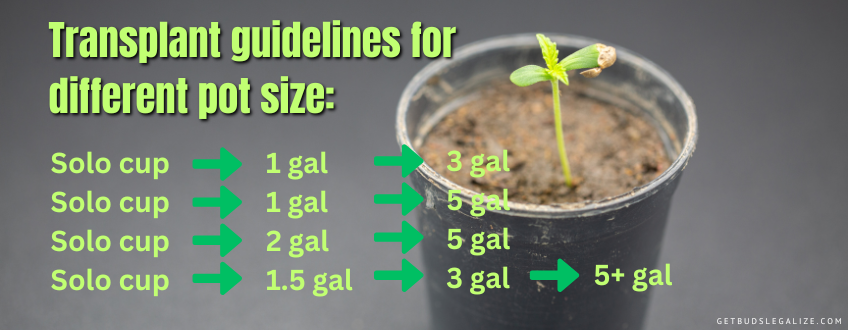
When transplanting your seedlings, make sure to handle them gently and avoid damaging their roots. You should also water them well before and after transplanting to reduce stress and shock.


https://getbudslegalize.com/cannabis-overwatering-vs-underwatering/
Commenti
Posta un commento